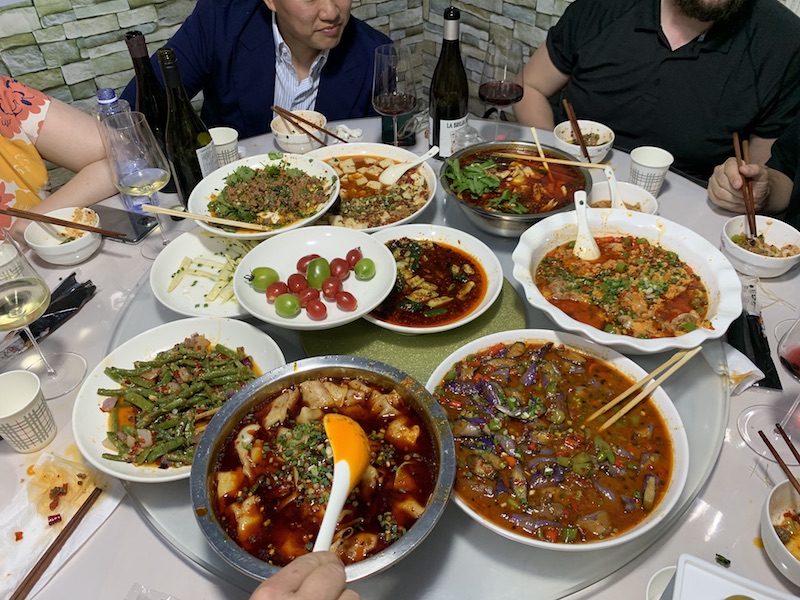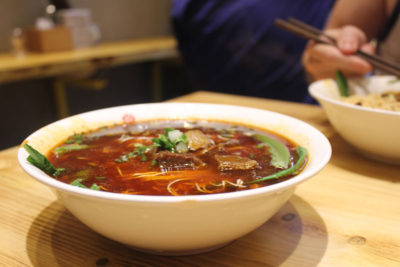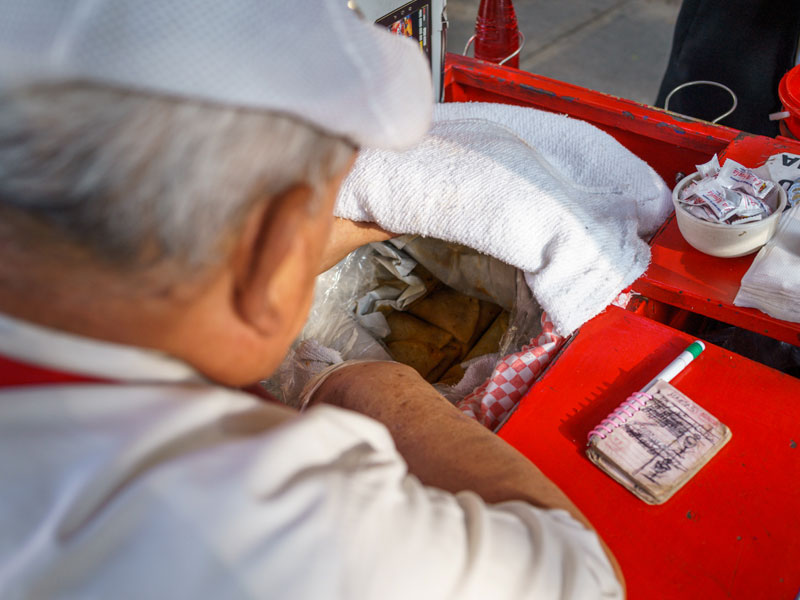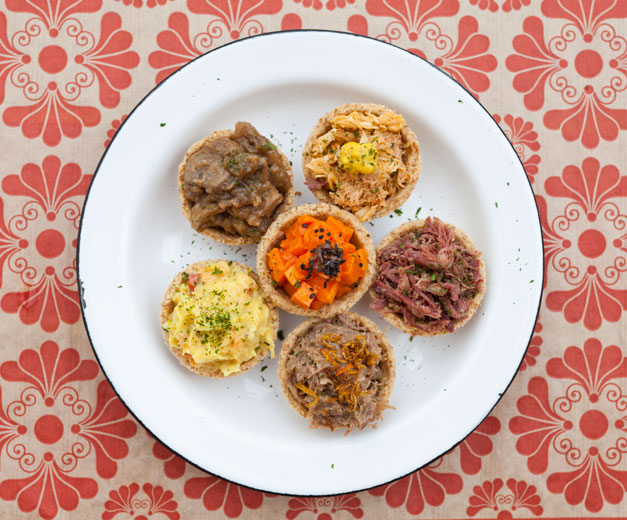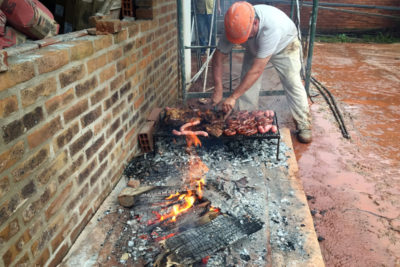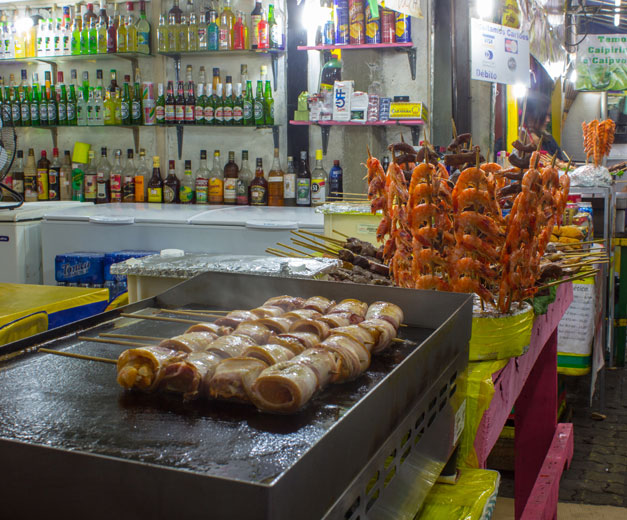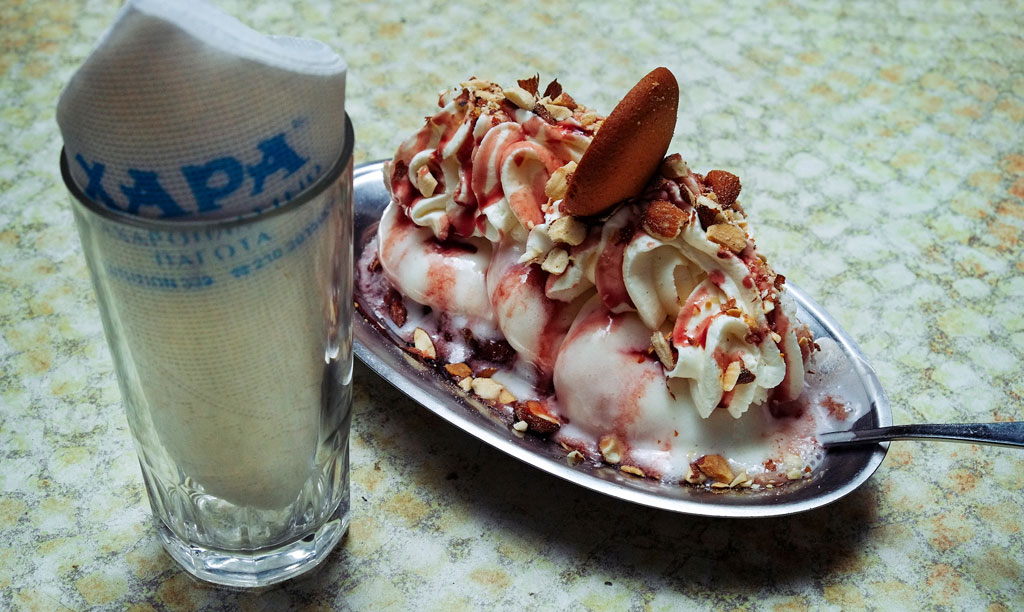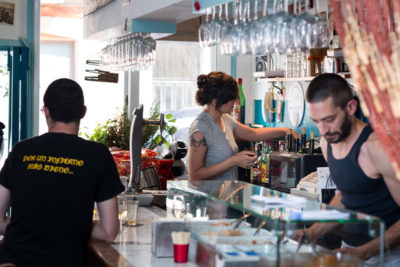We can't find the internet
Attempting to reconnect
Something went wrong!
Hang in there while we get back on track
Search results for
Shanghai
Miss Ali: All About the Lamb
Fun fact: More than 70 percent of the meat eaten in China is pork. And while stuffing yourself with xiaolongbao and hongshao rou is a must when eating in Shanghai, it can be nice to have a respite at halal restaurants like Miss Ali. Yan Ali, the owner and namesake of the restaurant, arrived in Shanghai from Xinjiang – China’s predominantly Muslim province in the country’s far northwest, where she previously hosted TV shows. Ali didn’t like the way her native cuisine was often represented in Shanghai – with waiters robed in garish “costumes” and performing songs and dances from their region – and decided to create a more accurate representation of the restaurants of Xinjiang.
Read moreAthens
CB on the Road: The Kataifi Master of Crete
Each morning, 82-year-old Giorgos Chatziparaschos’s bicycle pedals clank and echo down the cobblestone streets of the Venetian-era port city Rethymnon, on the island of Crete. For almost 60 years, he’s parked his bike in front of a 17th-century building where a simple hand-painted sign reveals his family name and his family business. By eight o’clock he has donned his apron and hat, and with the steely determination that underlies his work ethic, he begins to roll out the dough. Chatziparaschos is one of the only pastry makers in Greece specializing in handmade kataifi. The traditional phyllo pastry looks like shredded wheat, with strands as thin as vermicelli.
Read moreShanghai
Liu Family Harbin Dumplings: Pot-to-Plate Dining
[Editor's note: We're sorry to report that Harbin Dumplings has closed.] Walk along just about any street in Shanghai these days, and you’ll see an ever-encroaching range of Western brands, standardized brand signage and food franchises. As in other rapidly developing countries, the battle for consumer dollars and brand loyalty has meant more chains and mass-produced food. That’s partly what makes stepping into one of the several Liu Family Harbin Dumplings shops a breath of fresh air. Every morning until the lunch rush, the dining room and back rooms are set up with trays and workers dexterously making every dumpling from start to finish. Dumpling wrappers are meticulously hand-rolled, the fillings are mixed in large batches, and the time-consuming process of filling and closing the dumplings marches on until tray upon tray is ready for boiling.
Read moreMexico City
Fonda El Refugio: The Comeback Kid
Fonda El Refugio is a name that you will likely come across when looking at guides to Mexico City. The small restaurant in Zona Rosa, a popular tourist destination, has been serving authentic Mexican food for more than 57 years. Politicians, artists, writers and all kinds of celebrities have dined here over all those decades. Renowned writer Octavio Paz chose this restaurant’s food for his banquet with the Mexican president after receiving the Nobel Prize in literature in 1990. However, in recent years the quality of the food took a turn for the worse, and this iconic restaurant’s reputation took a major hit.
Read moreAthens
To Eidikon: Extra Special
At the corner of Psaron and Salaminos streets, in a quiet neighborhood of Piraeus, there’s a place that looks straight out of a 1960s Greek black-and-white movie. Its name, eidikon, means “special,” and it’s the last of its kind: a bakalotaverna, or grocery store and eatery, all in one. The shop opened in 1920, when the three Papakonstantinou brothers from Gardiki, an impoverished village near Trikala in central Greece, came to Athens in search of better prospects. The building was the tallest in the area. It had large windows, and in good weather, one could even see the sea on the horizon.
Read moreElsewhere
Pang Mei Mian Zhuang: Sinuses Beware
“Can you eat spice?” the waitress asked after taking our order. Her hand hovered hesitantly over the cash register. “Yes,” we replied. “But... Can you?” she asked again, looking to the other waitresses for help. “Yes!” we responded emphatically, trying to vocally convey our love of the tongue-tingling, lip-burning action we had come for. “Umm... These are Chongqing noodles. They are really spicy,” she said with her hand still in a no-man’s-land somewhere between our money and the cash register, unsure whether our foreign palate had what it took to slurp down a bowl of noodles from China’s spiciest city.
Read moreTbilisi
Art Café 144 Steps: Stairway to Gebzhalia
The 2010 makeover of Tbilisi’s old town broke the hearts of many locals and preservationists, who lamented the destruction of the neighborhood’s original 19th-century buildings and the fabrication of their cinder block replicas. The quarter hadn’t seen destruction on such a scale since the Persian ruler Agha Mohammad Khan razed the city in 1795. Instead of bemoaning the architectural tragedy, one local artist seized the opportunity to inject some positive vibrations into the precipitous hillside district by purchasing a small house underneath the 16th-century walls of the Narikala Fortress and turning it into one of Tbilisi’s coolest cafe-restaurants. Getting there, however, requires a bit of cardiovascular effort.
Read moreBarcelona
Granja Elena: From Farm to "Farm"
Despite the 1970s-era sign outside that says Granja (farm) and the red letters spelling “Bar” inside, you can’t really tell what this place is until you open the menu: a temple of “neighborhood haute-cuisine.” The food at Granja Elena sounds simple but tastes rich and complex. The restaurant is a family business, now run by the third generation – Borja, Patricia and Guillermo Sierra Calvo – in the same barrio in which it was founded in 1974, La Marina del Port. This modern neighborhood is part residential and part industrial, a bit far from Barcelona’s center, located near the merchant port behind Montjuic and on the way to the airport.
Read moreIstanbul
Behind Bars: Drinking in the Bosom of Abraham at Urfa’s Cafe Antik
Urfa's old city is an invigorating array of tones and sounds. Dominated by an intriguing maze of narrow streets, the buildings all share the same sun-baked sandy hue, suggesting that they rose up from the earth on their own centuries ago. Landscape and cityscape blend into one here, and cars are outnumbered by ornately painted motorbikes equipped with sidecars, vehicles perfectly equipped to navigate roads too narrow for vans and sedans. Older men don poşu scarves of varying color combinations, and Arabic is spoken more frequently than Turkish. Believed by locals to be the birthplace of Abraham, Urfa is known as the “City of Prophets.” The municipality proudly advertises this fact.
Read moreTokyo
Ichiran: Slurp in Private
There are times when food is just so profoundly, soul-satisfyingly good that we find it difficult to divert our attention enough to do the socializing often required when eating out with company. The folks who devised Ichiran Ramen must have taken that into account when they set up shop. Their concept is to offer complete personal space so that customers can give their undivided attention to the Hakata-style ramen served there. Imagine being encouraged to loudly suck up your ramen in the privacy of your own personal counter “booth.” Nobody really knows or cares who’s there, and whatever slurping happens there stays there.
Read moreLisbon
Scoop by Scoop: Lisbon's Best Ice Cream
In summer, there are just a couple of things that lisboetas will queue for: the beach and ice cream. The city is blessed with good places for both, but between the two, we prefer the latter, which in Lisbon tends to be Italian-style gelato, as served in the most long-lived and successful shops in town. Tucked away in a corner of Restauradores, A Veneziana still has the same façade and is run by the same family as when it opened in 1936. The shop is small, with a big esplanada, or terrace, on which customers can sit and enjoy their treats.
Read moreMexico City
Tacos de Canasta La Abuela: Inside Grandma’s Basket
Just a block away from Mexico City’s financial district one unlikely food star sets up shop every morning. From Monday to Saturday, at La Abuela, 72-year-old Arnulfo Serafin Hernandéz feeds hungry office workers, commuters, neighbors, school kids, government officials and tourists from all over the world with one of the simplest Mexican dishes: tacos de canasta. He fries a corn tortilla a little in lard or oil, fills it with one of the prepared ingredients, folds it in half and places it carefully inside a canasta, or basket. He wraps the tacos in cloth and covers them with plastic to keep them warm. This also makes them moist and soft when serving, two of the most important characteristics of a good taco de canasta.
Read moreAthens
CB on the Road: Syros, Secret of the Cyclades
As one approaches the port of Ermoupolis (named after Hermes, the god of commerce), the main town of the island of Syros and capital of the Cyclades, one cannot help but marvel at its beauty and grandeur. Imposing public buildings and private mansions, marble-paved streets, a large Italian-style piazza and numerous churches make the city one of the best preserved examples of 19th-century architecture in Greece. This should not come as a surprise: in the aftermath of the 1821 Greek War of Independence from the Ottoman Empire, Syros developed into an important commercial, cultural and industrial center, as refugees from Asia Minor, Chios, Crete and other areas found a safe haven from the war on the small island.
Read moreRio
Santa Filomena: Casually Serious, Seriously Casual
Like the classic optical illusion of the faces and the vase, look at Rio and you’ll see two sharply contrasting versions. First is the seemingly easygoing beach city of rubber sandals and gushy greetings as insincere as they are well intentioned. (“Passa lá em casa!” “Come by my home!” The carioca will actually be quite stunned if you show up at his home afterward.) On the other side of the illusion is the Rio that loves formality, titles, certificates and hierarchies. A Rio judge has a decade-long lawsuit against the doorman of his building, who refused to call him “doctor” and “sir,” which recently reached Brazil’s Supreme Court, which declined the case.
Read moreAthens
CB on the Road: The Unbeatable Mezedopoleia of Thessaloniki
One of the most popular kinds of restaurants in Greece is the mezedopoleio, which, as the name indicates, specializes in traditional local meze dishes (washed down with generous amounts of ouzo or other alcoholic drinks). Back in the day, mezedopoleia were the neighborhood’s meeting points. Men gathered there most of the day to drink, have a bite, talk politics and play backgammon, chess or cards. Today, the mezedopoleio remains a simple and very affordable place to eat, sometimes operating as a kafenio (cafeteria), and often offering traditional live music to add to the experience. Among Greek cities Thessaloniki is particularly famous for its numerous and excellent mezedopoleia, which makes it very difficult to choose just a few.
Read moreTbilisi
Tbilisi Sketches: Gobi, Georgia's Super Bowl
You sit down for a meal with family or friends, and no one can decide what to order. Well, some can, some can’t, and it goes on for ages. The waiter stiffens when you ask one more time for her to come back. But go to the basement restaurant of Shavi Lomi in Old Tbilisi, and you have the answer for dithering relatives and pals: the gobi, or “Friends’ Bowl,” filled with a colorful selection of classic Georgian dishes. The word shares the same root as the Georgian word for “friend” – megobari – and so, of course, a gobi bowl is for sharing. It’s a big wooden bowl, filled with a mix of different dishes and as many spoons as you need.
Read moreElsewhere
CB on the Road: Along South America's Asado Trail
In Argentina and Uruguay, asado – beef cooked over a parrilla, or open pit grill – is a fundamental part of local culture. On weekends, Sundays especially, grill smoke can be seen rising from backyards, rooftops and even small balconies, as well as, of course, from restaurant ventilators. Out of town, there are asados in chacras (small countryside farms) and in parks and picnic areas in forests. Asado’s defining role in these countries has existed for quite some time; it was even mentioned by Charles Darwin in his journals from 1833, when he was traveling towards Buenos Aires in the company of gauchos and native people.
Read moreRio
Feira de São Cristóvão: Northeast Beats (and Eats)
Let’s say you have only two or three days in Rio. You want to experience a little real Brazilian culture and don’t want to restrict yourself to the obvious tourist stops, overhyped bars and restaurants or usual “gringo” nightlife spots. Our recommendation? Spend a night or day – or both, even – at Feira de São Cristóvão. The feira, which means “fair,” is organized by people from the northeast (nordeste), which is the poorest region in the country. That poverty has led millions of northeasterners to migrate to Rio over the last 50 years to seek a better life. And Feira de São Cristóvão is where they express themselves culturally, musically and, last but not least, gastronomically.
Read moreLisbon
Tasca Kome: Osaka on the Tagus
After almost a century of desertification, it’s sometimes hard to believe the state of downtown Lisbon – Baixa – today. Hotels, startups, boutiques and restaurants are exploding up and down these long, narrow avenues, originally modelled on 18th-century Parisian thoroughfares, and all but abandoned by the 1990s. As the few remaining owners of the old light fittings shops and cheap canteens pray to the gods of damage limitation, a few of the new businesses do fit well into the surroundings. Japanese canteen Tasca Kome is one of them. Like all typical Portuguese tascas – traditional taverns and bars that serve food – the atmosphere at Tasca Kome is cozy and friendly.
Read moreWorldwide
Queens' Street Carts of Desire: The Vendors vs. City Hall
“The people with permits, they are not working. We vendors on the streets, we need more permits,” yelled Mehdi, a New York street vendor of Bengali origin, at a recent protest for more permits. Street vending in the city – in particular food vending – is largely the domain of immigrants like Mehdi, seemingly an easy way to start earning an income. But selling food from a street cart is no easy ride. Sean Basinski, Director of the Street Vendor Project, which advocates on behalf of street-based sellers, says food vendor licenses are relatively easy and inexpensive to acquire. There is no cap on the number of food licenses issued. There’s a catch, though.
Read moreBarcelona
CB on the Road: Queso de Mahón, Menorca's Big Cheese
At 10 a.m., Juan Trenado, head of cheese production at Finca Subaida, and his team had already been toiling for several hours. They moved efficiently through each step of the artisanal process, expertly crafting block after block of the famous Queso de Mahón on the Mediterranean island of Menorca. “By law” – Mahón has a protected designation of origin (D.O.P.) – “the cheese could include a little sheep’s milk, but ours doesn’t,” Trenado told us, as he directed a gushing stream of watery cheese curds from a wide hose into a big, waist-high stainless steel vat. Slowly, the vat filled nearly to the brim, and Trenado, along with Mònica Mercadal, Head of Cheese Maturation, and Ramon Alonso, a new hire, carefully stirred the curds, breaking them into small chickpea-sized pieces.
Read moreMexico City
Market Watch: Near Mexico City, the Far Out Tastes of Tepoztlán
No matter how long your stay in Mexico City, you’ll simply never “taste it all.” In the cycle of each day, from tamales, atole and morning licuados to midday comida and evening tacos, this great culinary city is in perpetual motion. Want Yucatecan cuisine? Oaxacan? Restaurants abound where you can experience the cuisines of other regions, but the street food, fondas and market stalls in general reflect the regional cuisine of Estado de México. To properly understand “Mexican food” and its regional diversity, get out of town. Just a little more than two hours from Mexico City’s Centro Historico is a Pueblo Mágico called Tepoztlán. The bus ride there passes through three national parks along the way.
Read moreTbilisi
Pkhali at a Summer Favorite Outside of Tbilisi
Phkali, in spite of it's meaty appearance, is actually a vegetarian-friendly Georgian specialty of beets, ground walnuts, vinegar, onions, garlic, and herbs. This version is from Armazis Kheoba, a favorite of ours just outside Tbilisi.
Read moreAthens
CB on the Road: Going Deeply Local in Heraklion
“We say if you leave a Cretan pappou [grandfather] alone in the Cretan mountains, six months later you’ll find him fatter,” said dietitian-turned-restaurateur Panayiotis Magganas. He smiled wide. “Our land is incredibly rich.” The fertility of Greece’s largest island is part of the inspiration behind Peskesi, his restaurant in old town Heraklion that showcases the diversity of Crete’s cuisine through recipes he says are slowly being forgotten. “Even people from Crete don’t know some of these dishes,” he said. Set in an intricately refurbished Byzantine-era mansion, the restaurant still retains some of the charming details of the once-collapsing space, including a 100-year-old lemon tree that is the centerpiece of one dining room.
Read moreRio
Quiosque do Português: A Funky Caipirinha Hut Grows Up
It might have become one of the more fashionable places in Rio for a caipirinha, yet the name of this father-son joint – “Portuguese Kiosk” – suggests humility. Indeed, the pair got their start a decade ago in one of the numerous huts that line the city’s beaches. While the majority of their competitors served the tasty, tried-and-true Rio basics – traditional caipirinhas made with cachaça; beer and French fries – to sandy-toed beachgoers, Manoel Alves, now in his early seventies, wanted to offer something different. He tried importing cheeses from Portugal, his parents’ homeland (hence the venue’s name), but found that the international products went bad too quickly to please health inspectors.
Read moreWorldwide
Queens' Street Carts of Desire: Peddling, Past and Present
Queens these days is New York’s street cart central. According to the Street Vendor Project, which advocates for vendor rights in the five boroughs, the largest concentration of street vendors with licenses lives in that borough. This concentration of streetside sellers is easy enough to see on six-mile-long Roosevelt Avenue, which runs through six of Queens’ most ethnically diverse neighborhoods with a dizzying assortment of vendors catering to almost every taste and nationality, depending on the time of day. It’s not always easy work. At a recent monthly meeting of street vendors in Corona, Queens, the air was thick with grievances about the conditions they have to work under.
Read moreTbilisi
Kakhelebi: Kakheti Calling
We were cutting grapes in a vineyard in eastern Georgia’s Kakheti region when two young men led a goat by a rope to a nearby tree and sliced its neck with a hefty hunting knife. Our lunch. They offered us a sliver of fresh raw liver with sardonic smiles, insisting it was the best part, but we passed and waited for the meat to be cut, skewered and roasted over the coals of tsalami, or vines. Served with bread, razor-sharp sheep cheese, whole tomatoes, cucumbers and rkatsateli wine, nothing could have been more Kakhetian. Since that harvest, we have been to scores of Kakhetian restaurants in Tbilisi, most of which were gratifying, but none had goat on their menus.
Read moreElsewhere
Xara: Just Like in the Movies
Watching old Greek movies from the 1950s, '60s and '70s has been a rite of passage for every single generation raised in Greece from the '80s onwards. When we were young, these movies played endlessly on TV, getting us acquainted with the Greece our parents grew up in.There were a number of things that both puzzled and delighted us – chief among them, the patisserie-as-meeting-place. The heroine, wearing a pillbox hat over expertly coiffed hair, would meet her girlfriends or potential love interest in grand-looking pastry shops, where she would be served by waiters in uniforms and eat a pasta, an individual portion of dessert: soft sponge cake with almond and cream or chocolate fillings.
Read moreLisbon
On the Waterfront: Cacilhas, the Other Side of Lisbon
Cacilhas is the waterfront area of Almada, a small city reachable via a €1.20 ferry ride from Lisbon’s Cais do Sodré terminus. The district is heavily marked by its shipbuilding past and has an industrious character that, for now, is still preserved in its food culture. Right in front of its boat station is a concentration of traditional marisqueiras, typical seafood houses from where you can glimpse a sweeping view of almost the whole of Lisbon across the other side. The seafood platter is a must in any of these traditional spots. It is usually composed of stuffed crab, spiny lobster and giant prawns, accompanied by the classic amêijoas à bulhão pato – clams cooked in garlic, coriander, pepper and olive oil.
Read moreRio
Olympian Appetites: Rio's Top 9 Eating Experiences
Athletes, spectators and everyone else gathered in Rio for the Summer Olympics will have no shortage of good eating options – and not just in the usual touristed areas. We’ve rounded up some of our favorite spots around town. CADEG The 100,000-square-meter market is divided into three warehouse-style floors, with a pavilion just for flower sales at the rear of the second floor. (The building sits on an incline, so you can enter from the street either on the ground floor or from behind the second.) The market is open 24 hours. Early mornings on Thursday and Saturday are the top time for flower shopping. Saturday afternoon is Cantinho das Consertinas’s Festa Portuguesa, with up to 1,000 attendees queuing for a host of salt cod dishes on the second floor.
Read moreLisbon
Tentações de Goa: (Tri)continental Cuisine
Hidden within Mouraria’s maze of narrow streets is a tiny eatery offering usually hard-to-find fare in Lisbon: Goan cuisine. Situated a couple of minutes away from Martim Moniz – a revamped square that some years ago was named the multicultural core of the capital – this haven of flavors is a veteran of food diversity in the neighborhood. Tentações de Goa (“Temptations of Goa”) opened 20 years ago, when the multi-ethnic character of the area was more marginalized and not considered cosmopolitan, and when international restaurants were not as numerous and crowded as they are today. In the 1990s Maria, the now-busy owner of the small restaurant, was just a regular customer here, an avid fan of the elderly Goan woman who originally ran the place.
Read moreShanghai
CB on the Road: Chengdu's Fly Restaurants
When you’re in the capital of Sichuan province, snacking is a way of life. Noodles made of bracken, wheat, chickpeas, mung beans and more, as well as tofu puddings and dumplings, make up the city’s “small eats” (小吃, xiǎochī) scene, served from what’s colloquially known as “fly restaurants.” A step above street food, these family-owned eateries are so called because they attract diners like flies, despite what might seem like a less-than-hygienic atmosphere, because the food is too good to miss. Find a hole-in-the-wall that has more diners than stools, and order one of these local specialties for a delicious meal.
Read moreRio
Quintal Gourmet: House of the Loving Son
Quintal Gourmet is the story of a doting son, one who's also delighted to be able to spend more time in his home, the City of God. Yes, the one from the movie. Carlos Vinícius, 29, a man as towering as he is smiley, looks at his mother, wiry and fast-talking Joyce, with a doe-eyed affection that seems to be deeply mutual. "I always followed my mom," he says. Before Quintal Gourmet, the two worked as domestic help, with Carlos Vinicíus a caretaker for an elderly woman. When his 72-year-old patroa passed away, he longed to spend more time with his own community rather than leave the favela each day for work.
Read moreIstanbul
Chaos and Köfte: Istanbul Rebounds After Coup Attempt
On the night of July 15, electricity consumption on the European side of Istanbul rose by a staggering 52 percent. People frantically clutched their smartphones, plugged in their chargers, and remained glued to their TV screens. Turks watched with terror as a military coup attempt played out like a twisted B action movie. Tanks ran over people and shot them in the street. An F-16 left a sonic boom in its wake sounding no different than an exploding bomb. Jets fired on the parliament building in Ankara.
Read moreAthens
CB on the Road: Thessaloniki's Infinitely Delicious Pie
Like so many other Greek specialties, bougatsa has a long history, in this case one that stretches all the way back to Byzantine times. Bougatsa is mainly a breakfast pie with a phyllo pastry made of flour, softened butter and oil that requires a great deal of skill to prepare. This pie is made and enjoyed all around Greece, but particularly famous are those made in northern Greece, especially in Thessaloniki and Serres. Turkish börek is a close relation, and similar pies are traditional to many eastern Balkan countries that were formally part of the Ottoman Empire. The tradition of bougatsa making really took off around Greece in the early 1920s with the arrival of the Greek refugees from Asia Minor and Cappadocia.
Read moreLisbon
O Satelite da Graça: Down to Earth
Perched on Lisbon’s highest hilltop, Graça has a villagey feel and is probably the best district to absorb stunning views over the Portuguese capital. Home to plenty of bakeries, cafes and two of the city’s most beautiful viewpoints, it does, however, risk irreversible damage because of the real estate boom affecting much of the city center. It is, for now, still a charming area, with an elderly population and remnants of working-class neighborhood life. To get to the panoramic views during summer, there are two options that don’t involve being stuck in a taxi: climbing steeply up through the irregular lanes of Alfama or Mouraria, or following the route of the iconic and crowded tram 28.
Read moreBarcelona
La Chana: Andalusian Flavors, Hold the Flamenco
“I missed the traditional foods I grew up with in Cádiz,” said Natalia García, a young woman with dark hair, bright red lipstick and a smattering of tattoos across her upper arm. “I was actually born in Germany, and my mother was a professional cook, so I was always around food,” she tells us. Despite the German heritage, García’s strong accent and open, friendly demeanor are pure Andalusia. “Whenever I told people [in Barcelona] I was from Cádiz, they would get excited. Everyone loves Cádiz, especially the food.” After living in Barcelona for just one year, García decided to open La Chana, a bar that reminded her of home, in the heart of the non-touristy neighborhood of Poble Sec.
Read moreTbilisi
Tbilisi Sketches: Slow Cheese
Take the plunge into the high-volume hubbub of Tbilisi’s famous Deserter’s Bazaar and you’ll come under a three-senses assault. The piquant aroma from the spice stalls, a butchers’ shouting war and stalls swinging with burgundy-brown, candle-shaped churchkhela sweets. But on one side of the market building, there’s a small slice of calm – in the long corridor where the cheese sellers work. Selling homemade cheeses from across the country, delivered fresh every day, is a more relaxed and deliberate business. You’ve heard of the Slow Food movement. Perhaps it’s time we were more specific and talked about “slow cheese.” Here, the cheese sellers prefer to wait for the customers to come to them.
Read moreTokyo
Umeshu Dining Myoujou: Drink to Your Health
Long valued for its medicinal properties, the East Asian stone fruit ume appears in Japan’s oldest pharmacological dictionary, written in 918. Something between a plum an apricot, the ume is more acidic than both and rich in antioxidants. The first mention of umeshu, a liqueur made by steeping ume in usually distilled spirits and commonly translated as plum wine, came centuries later in a book of Japanese cuisine published in 1697. Ume’s medicinal value appears to have carried over, though, as this later work claims that the flavorful tonic both spurs the appetite and counteracts poisons.
Read moreTbilisi
Armazis Kheoba: Down by the River
Summer in Tbilisi means sweet and sour cherries, plums, apricots, peaches, fresh figs, watermelons and, most importantly, tomatoes that taste the way God intended them to. It’s a season bursting with flavors – but there’s a hitch. Tbilisi summers are oppressively hot and humid, the thick, gritty city air leaves a mucky film on the roof of your mouth, stifling your appetite and keeping you out of your favorite local eateries. Everyone evacuates the capital in the summer, and if we can’t manage to get out of town for weeks on end, we can at least drive 15 minutes to spend an afternoon at Armazis Kheoba for some lungfuls of fresh air and beef liver mtsvadi.
Read moreBarcelona
Summer Picnics: Feasting Outdoors in Barcelona
Maybe it’s the fresh air, maybe it’s the smell of the grass and the trees or maybe our senses are more alert, but it seems to us that when we eat outdoors, food just tastes better. And Barcelona, blessed as it is with so many sunny days, a municipal market in every neighborhood, a growing number of gourmet food stores and many excellent traditional food shops and stalls, is a great city to spread out a picnic blanket for an alfresco feast. To enjoy a good meal under the blue sky, you can choose from more than 80 different green spaces:
Read more

